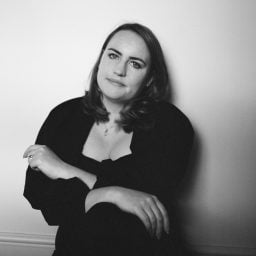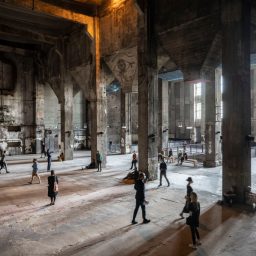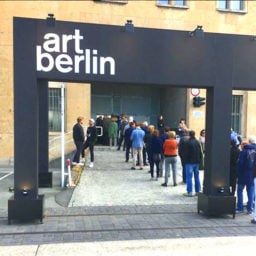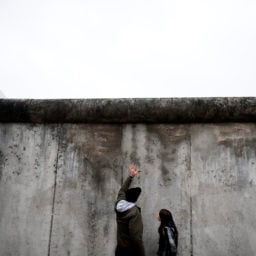The annual Berlin Art Week is back this week for its seventh edition, kicking off tomorrow (September 26) and sprawling across two art fairs, 16 institutions, 11 private collections, and 20 project spaces. As always, Berlin Art Week draws in an international crowd with a multi-branched and decentralized program, becoming something of a city tour in itself.
This year, there are some new additions to the map. These include Deutsche Bank’s PalaisPopulaire, which is opening in a building that used to be home to the Deutsche Guggenheim, and the historic Tempelhof Airport, which is serving as a venue for both art berlin and Positions Art Fair, which are sharing the same roof for the first time. This year’s art week also coincides with the European Month of Photography. The British photographer Martin Parr is in town for an artist talk at the institution C/O, and there are several other openings and events dedicated to the medium.
With so many exhibitions, along with events, performances, and talks going on, we have highlighted some of the must-see shows and events to add to your itinerary.
Simon Fujiwara at Esther Schipper
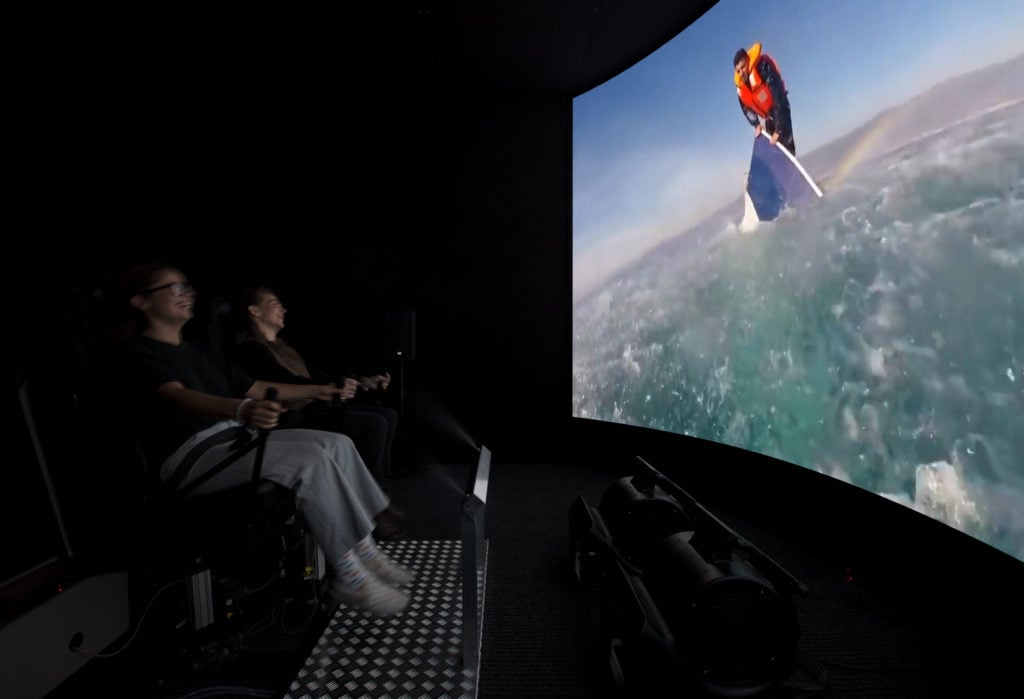
Simon Fujiwara’s Empathy I (2018). 5D simulator installation (with video, sound, motion, water, and wind). Photo © Andrea Rossetti. Courtesy of the artist and Esther Schipper, Berlin.
If you go to see Simon Fujiwara’s first solo exhibition with Berlin’s Esther Schipper, expect to take a number and wait a while. The gallery has been turned into an extra-large waiting room, and the only reading material is Fifty Shades of Grey, opened to a passage about submission. Fujiwara wants you to be in a submissive mood in order to enter into his art, it seems.
A Sicilian company that normally produces theme park rides collaborated closely with Fujiwara to construct his massive, immersive installation that seats two viewers at a time. Fujiwara has paired it with a film of culled YouTube footage, edited down into a rapid succession of moments of high intensity that the viewer experiences in first person. One second it’s “your” wedding, and the next you are watching a man in a life jacket sitting on top of a sinking lifeboat. At some point you feel you are being beaten up.
The video is over almost too quickly, with Fujiwara’s ride clocking in at just under four minutes, encompassing surprising jolts, water, wind, and a journey around the world in that time. Fujiwara tells artnet News that the duration is not random, but rather scientifically known to be just short enough so that you don’t have the chance to quite normalize or understand what you are seeing. And then the core question: Where does empathy fit into that? Is it heightened or is it eradicated?
In the spirit of acceleration, the show will only be on view until the end of this week. After that, Fuijwara’s emotional incubator Empathy I travels to his next solo presentation at Lafayette Anticipations, opening in Paris on October 13.
“Empathy I” is on view for extended hours on September 28, from 6 p.m.–9 p.m., and then through September 30, Esther Schipper, Potsdamer Straße 81e, 10785 Berlin.
Julian Charrière at Berghain
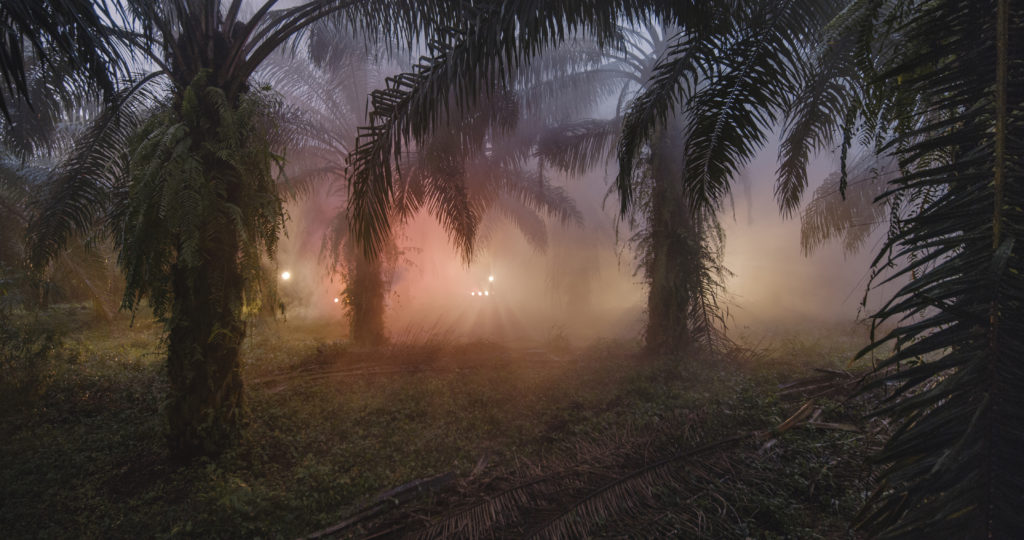
Julian Charrière, film still from An Invitation to Disappear (2018). copyright the artist; VG Bild-Kunst, Bonn, Germany.
The eruption of the Tambora volcano in 1815 created a world of darkness and extreme weather. In Europe, the “year without summer” inspired Mary Shelley to write Frankenstein. Now, the Swiss-French artist Julian Charrière and Ed Davenport, a British producer and DJ who also goes by the name Inland, have taken the historic eruption and extreme weather it caused as a departure point for their new multimedia work An Invitation to Disappear.
In parallel to Charrière’s exhibition at Berlinische Galerie (where the video component is also on view), the artist will present an 80-minute film at Berghain, Berlin’s most infamous night club. The work includes a high-definition tracking shot that captures dawn to dusk at an Indonesian palm plantation. Inland will perform a live set which was developed in tandem with Charrière’s film. An accompanying publication of images and film stills, as well as the new LP by Inland, will be available. An exhibition partnership between a city’s key institution and a techno club is perhaps something that could only happen in a city like Berlin.
Charrière was also awarded the biannual GASAG art prize of €10,000 ($11,800) at the opening of his exhibition at the Berlinische Galerie, called “We Used to Float.”
Julian Charrière and Inland’s An Invitation to Disappear will be live at 11 p.m. on September 26 at Berghain, Am Wriezener Bahnhof, 10243 Berlin.
Geta Brătescu at Neuer Berlin Kunstverein
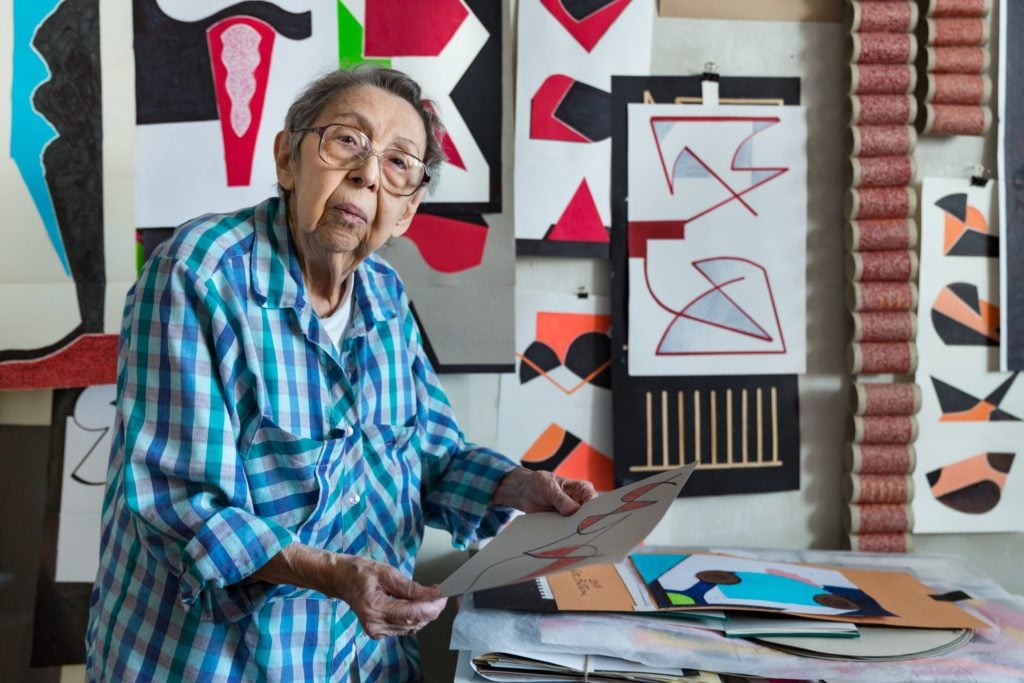
Geta Brătescu. Photo by Cătălin Georgescu courtesy of the artist, Hauser & Wirth, and Ivan Gallery.
The veteran Romanian conceptual artist died just weeks before the Neue Berliner Kunstverein was due to open her first solo exhibition in a Berlin institution. Geta Brătescu was an important figure in the Eastern European avant-garde who gained international recognition and major gallery representation late in life. Last year, she represented Romania at the Venice Biennale, at age 91, and joined the roster of Hauser & Wirth.
Featuring historical and late works by the artist, the exhibition includes a new film, which Brătescu created with Ștefan Sava. The exhibition focuses on Brătescu’s engagement with the studio throughout her 60-year career. Brătescu’s oeuvre, much of which centers around important questions about female subjectivity and gender, is diverse and includes everything from drawings to collages to performances, experimental films and photographs, as well as objects, and sculptural installations.
“Geta Brătescu” opens on September 26 at 6 p.m., and will be on view September 27 through January 25, 2019 at Neuer Berliner Kunstverein, Chausseestrasse 128/129, 10115 Berlin.
Agnieszka Polska at Hamburger Bahnof
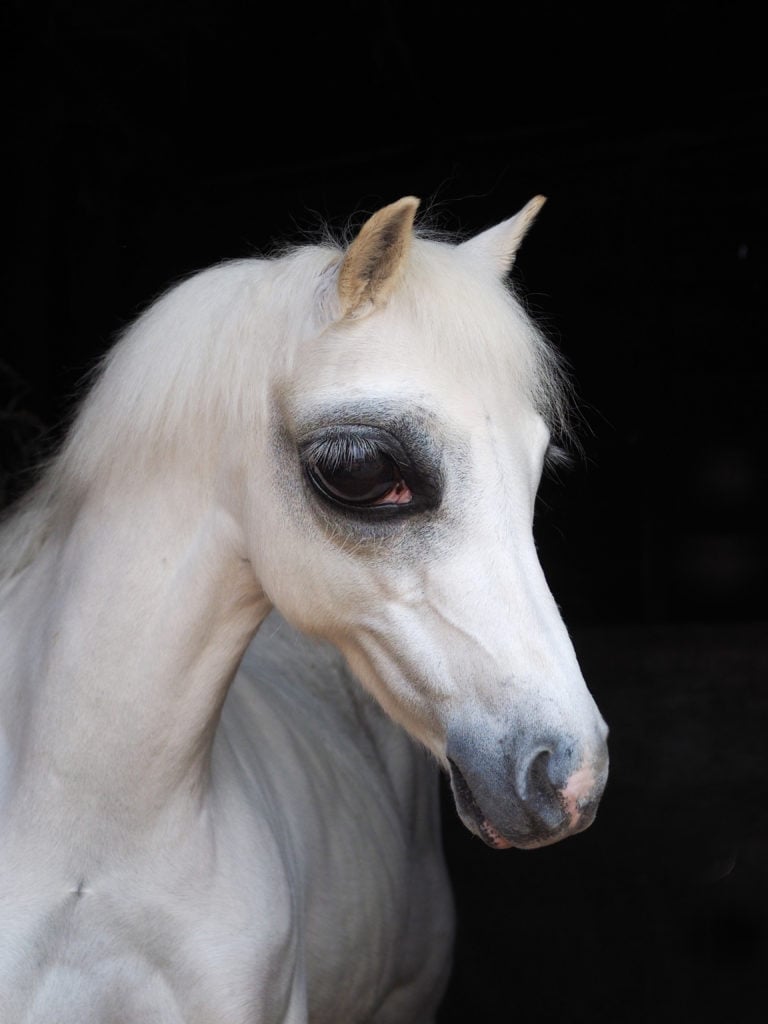
Agnieszka Polska, Horse Head, (2018). © Agnieszka Polska.
This exhibition is part of Agnieszka Polska’s reward for winning the prestigious Preis der Nationalgalerie, the biennial prize for Berlin-based artists under 40. (Anne Imhof numbers among previous winners.) Polska, who is Polish and based in Berlin, took the title from the three other foreign national female artists nominated for the prize. (They all called out the prize organizers for over-emphasizing their nationalities, diversity, and the fact that they were women.)
“The Demon’s Brain” is a multi-channel video installation comprising animation and filmed sequences based around archival correspondence from the 15th century. Letters exchanged between the Polish official who managed the salt mines, Mikołaj Serafin, and various creditors and debtors reveal the beginnings of a capitalist operation within the feudal system (Serafin leased the mines from the king). As usual, Polska’s films are highly visual, yet minimal in their visual subject, as the artist pares her work down to a selection of poignant and enduring motifs.
Polska’s installation explores a fictional backstory of the illiterate messenger who delivered these communications. The messenger is one day lost in the forest, and an unexpected encounter prompts a hallucinatory vision linking the unsustainable mining of the country’s raw materials to the Christian notion of the apocalypse.
“The Demon’s Brain” is on view from September 27 at 6 p.m. The exhibition will be on view from September 27 throughat Hamburger Bahnof, Invalidenstr. 50/51, 10557 Berlin.
Salon, Curated by Tenzing Barshee at art berlin
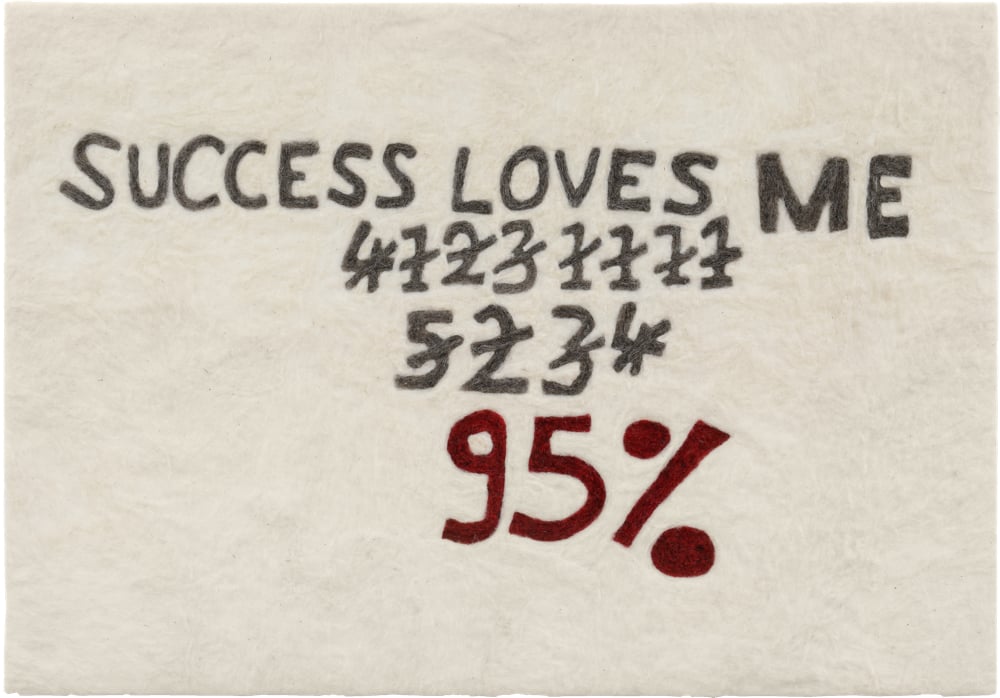
Elif Erkan, Does Success Love Me? (2018) © weiss berlin.
The Berlin fair is launching a new concept booth, with 50 works from 40 galleries showing side-by-side in a 330-square-foot booth. Swiss curator Tenzing Barshee worked together with the Italian artist and architect Alessandro Bava to design the “anti-booth,” which aims to act like something of a labyrinth to maximize wall space.
The booth also gives galleries who may not be able to attend in full capacity the opportunity to have a presence at art berlin. Other galleries, like Sprüth Magers, will have both a booth of their own at the fair and works curated into Salon, including contributions from Andreas Schulze, Karen Kilimnik, and Jenny Holzer.
The second edition of art berlin takes place at Tempelhof airport from September 27–30 at hangars 5 and 6 at Tempelhofer Damm 45, 12101 Berlin.
Evelyn Taocheng Wang at KW Institute for Contemporary Art
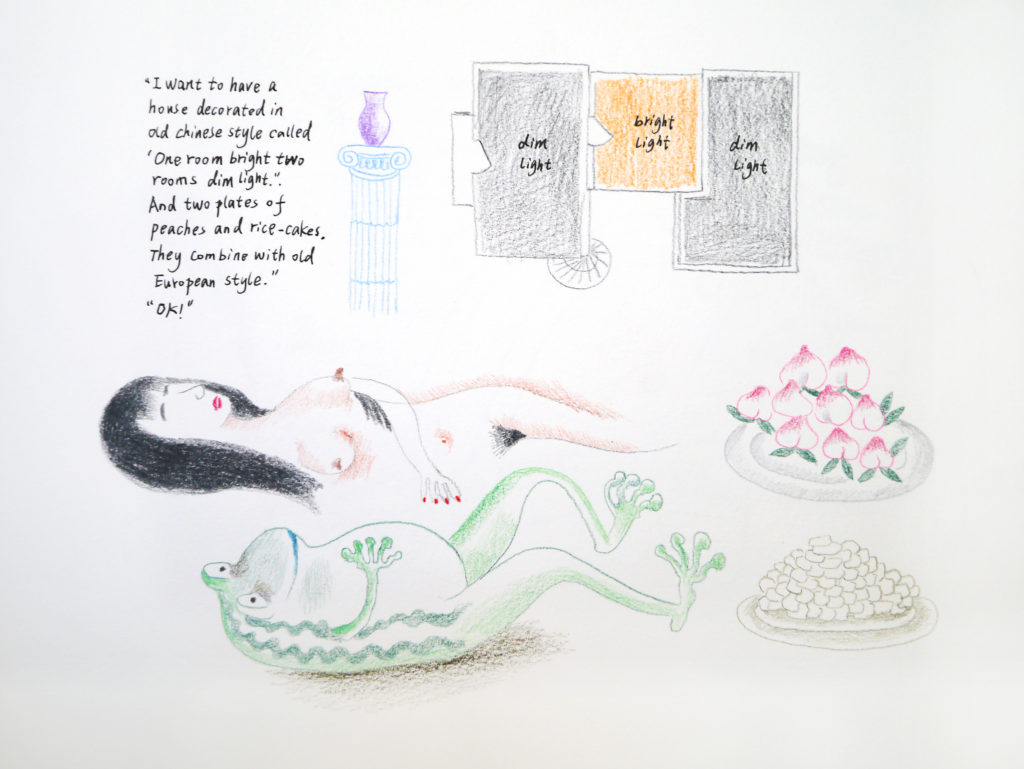
Evelyn Taocheng Wang, Cool Smell Room (2018). Courtesy of the artist
KW Institute for Contemporary Art presents an interim exhibition by Chinese artist Evelyn Taocheng Wang, running from Thursday to Sunday this week in the venue’s main concourse hall. The Amsterdam-based artist works across classical illustration and painting to video and performance, playing with notions of truth and fiction, gender, and identity. This site-specific presentation marks the artist’s first solo show in Germany. It follows her performance piece in documenta14.
Wang studied traditional Chinese painting in her hometown of Chengdu, China, before moving to Germany to go to the prestigious Städelchule, studying under the Dutch conceptual artist Willem De Roy.
The large exhibition space is divided up with billowing fabrics, reminiscent of hospital partition walls. They create semi-private rooms in which to view the artist’s two new films, Hospital Conversation (2018), and Three Versions of Change (2018).
The exhibition is a continuation of a dialogue sparked between assistant curators Maurin Dietrich and Cathrin Mayer for Wang’s performance piece at KW’s Bob’s Pogo Bar last year. “Unintended Experience: A job in Amsterdam” focused on conversations surrounding her under-the-table employment in a massage parlor. Dietrich and Mayer will be with Wang for an artist’s talk on Sunday at 5 p.m. in KW’s studio.
“What is he afraid of” is on view from September 26 at 7 p.m. at KW Institute for Contemporary Art, Auguststraße 69, 10117 Berlin.
Lee Bul at Gropius Bau
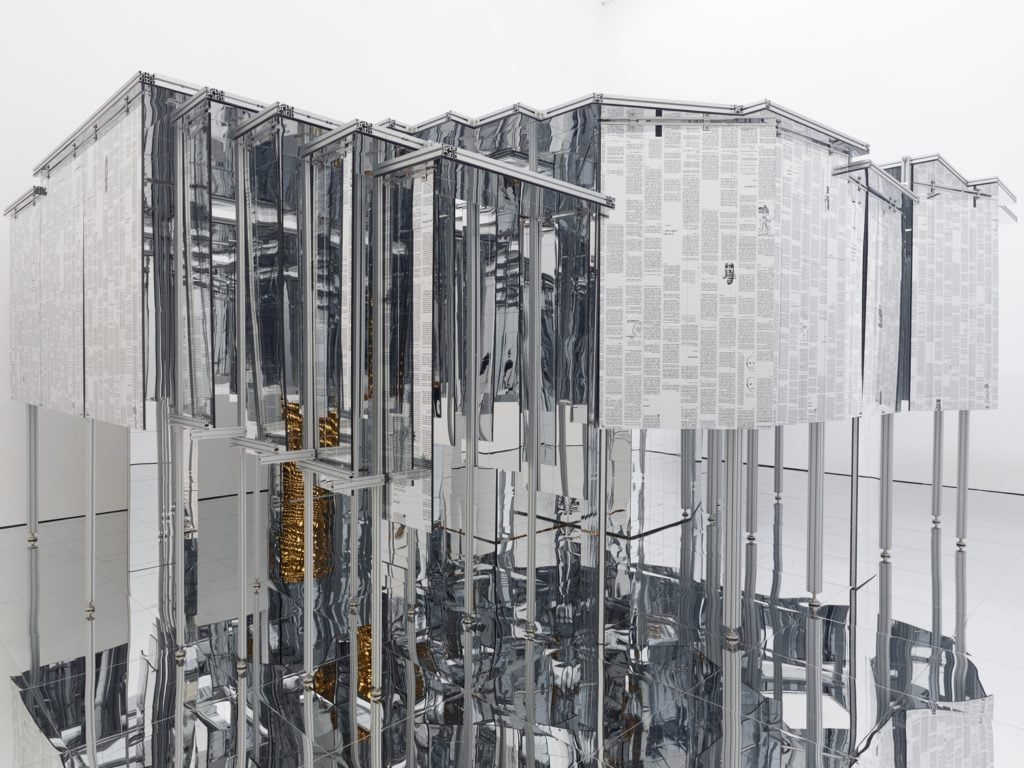
Lee Bul, Via Negativa II (2014). Photo by Elisabeth Bernstein, courtesy of Lehmann Maupin, New York and Hong Kong.
Following a successful leg at London’s Hayward Gallery, the large-scale survey of the Korean artist’s provocative work is Lee’s (long overdue) first solo exhibition in Germany. The influence of science fiction and futurist theories on Lee’s work can be felt as mini architectural visions of entire cities meet her ambitious installations and costumes.
The works on show in “Crash” speak to Bul’s own humor while conveying subtle messages about Korea’s political history throughout her 30-year artistic career, which spans South Korea’s evolution from a military dictatorship to an uneasy democracy, and a continued stand-off with North Korea.
From videos of her early performances to installations including an enormous helium airship, a sound-activated cave, and a personal karaoke booth shaped like a sports car. Conspicuously missing, however, will be her early work of bags of rotting fish Majestic Splendor, which was removed from the London show due before the private view after it began to self combust during the installation process. There will however be a video installation that shows stills as a slide show from the work’s incident free 1993 iteration.
The new show at Gropius Bau is the first to open under the directorship of Stephanie Rosenthal, the former chief curator of the Hayward Gallery.
“Crash” is on view from September 28 at 7:30 p.m. at Gropius Bau, Niederkirchnerstr. 7, 10963 Berlin.
The World on Paper at PalaisPopulaire
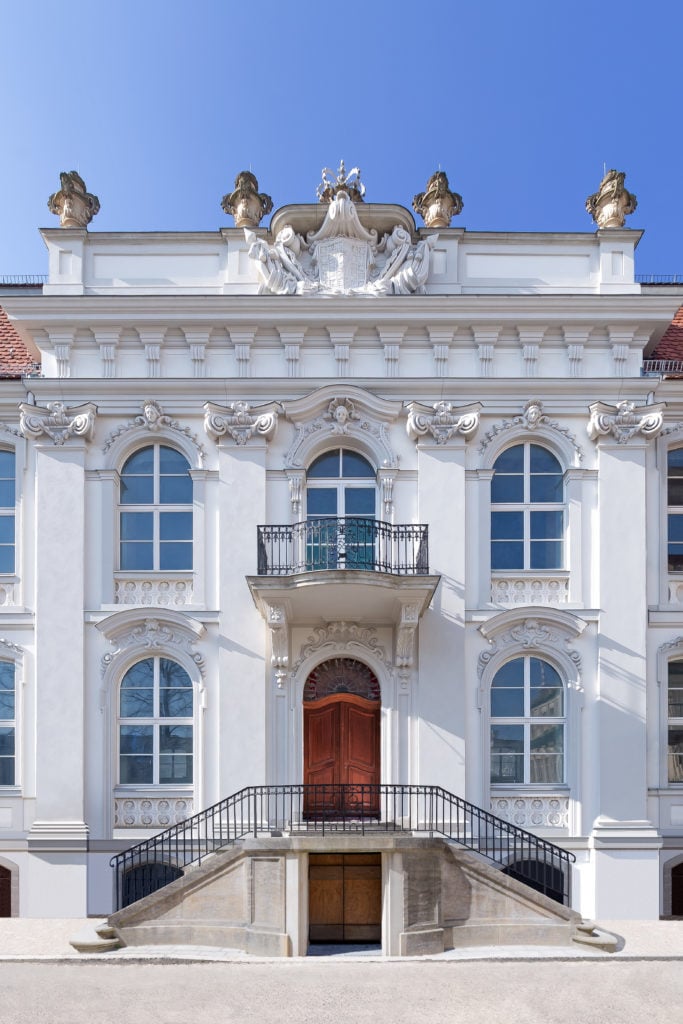
PalaisPopulaire exterior view. Courtesy of PalaisPopulaire.
The Deutsche Bank’s newly opened art center, the PalaisPopulaire, is showcasing around 300 works by 133 artists from the Deutsche Bank Collection. “The World on Paper” promises to show the collection from a new perspective, emphasizing its variety, history, and international scope. Focusing on the collection of paper-based works, the show will feature artists including Katharina Grosse, Ellen Gallagher, and Wangechi Mutu.
The exhibition spans over 50 years of works on paper, beginning with a work by Austrian artist Maria Lassnig from 1948, and working up to a more recent acquisition by Swiss artist Zilla Leutenegger from 2018.
All three levels of the former palace turned Kunsthallen will each be dedicated to a distinct thematic “world on paper.” The first part will examine abstract art, and the following two areas will look at self-image, the body and identity as well as personal and collective history.
“The World on Paper” is on view from September 27 through January 2019 at the Deutsche Bank’s PalaisPopulaire, at Unter den Linden 5, 10117 Berlin.
Berlin Art Week takes place across many venues in Berlin, from September 26 through 30. For more information and to learn about their full program, click here.











